di Marco Maculotti
cover: Ferdinand Keller
Here we aim to bring to a conjunction some cycles of articles published so far in this first year of activity of AXIS world: the cycle concerning i Cosmic-agrarian cults of ancient Eurasia, the one focused on the question of Time and cosmic cycles and finally the series of lectures by M. Ruzzai on the Myth of the polar and hyperborean origin of humanity.
Kronos in exile: the "Islands of the Blessed"
It tells the Greco-Roman myth, which has come down to us mainly thanks to the writings of Plutarch, who Saturn / Chrono, following the dethronement by Jupiter / Zeus, no longer resides in this world, but lives in a comatose state in the extreme North-West, on the edge of the earth, far near Okeanos. Here, on an island called now Elysion ("Isle of the Blessed") now Ogygia (lit. "the primordial"), the god of the golden age lies dormant in a golden cave together with some blessed souls (or "good demons") who are equally removed from the flow of becoming, since that island — real locus amoenus—it does not experience those processes of deterioration or cyclical change to which the whole cosmos is subject: there is one eternal spring, there are no thunderstorms, snow or rain.
It is said that "in this region surrounded by a perennial sunset, the blessed kidnapped, adorned with wreaths and flowers, live their dream life, without toil and without operating"[Philipsson, Origini and forms of the Greek myth, p. 209], similarly to humanity in the Hesiodic Golden Age. These "blessed kidnapped" would be, according to Hesiod, who are "the divine race of Heroes, more just and more good"; for these merits they "live happily and without worries in the islands of the Blessed, near the Okeanos with great happy whirlpools". Nuccio D'Anna [The cosmic game, p. 83] comments:
The idea […] that the islands of the Blessed are located near Okeanos will be developed by Plutarch […] who places it in connection with the golden kingdom of Kronos. It is the place where the sun almost never sets and while Kronos sleeps, like the men of the golden age, extraordinary birds bring him the divine ambrosia and strange servants-scholars reach him every thirty years, ie at the completion of the entire celestial cycle of the planet Saturn.
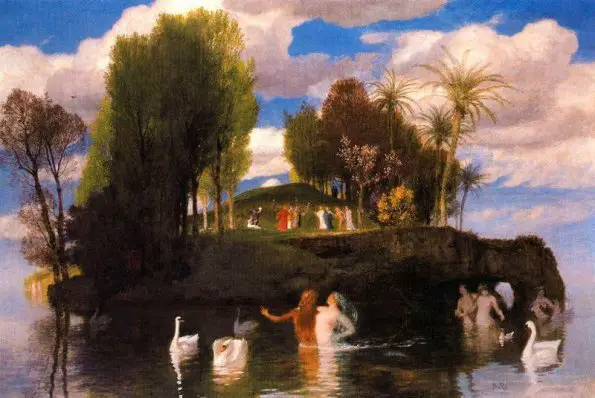
In Celtic tradition, certainly influenced by the Mediterranean one, we find some surprising similarities on this theme. In fact, it is said that Kronos lies asleep in a golden cave in the mountain, near the "island of immortality", the "island of apples" where is the "water of life" (the sacred island Avalon it is etymologically connected to Apollo — hyperborean god, double of Saturn — and to the term ang. apple and therefore the "apples of the Hesperides"). However, three giantesses - similar to Norns, whose will not even the gods can question — break this idyllic existence. They represent the three phases of the moon and the triplicity of time: past, present, future, of which the moon is the measure. The three figures would have initiated the becoming [Ruini, p. 18]. Nin the Celtic-Irish tradition the Isle of the Blessed is also called Tir na mBeo (The "Land of the Living") to Tir na hOge (The "Land of Youth"), to testify to the complete absence of death and old age, due to the timelessness of the place, from this locus amoenus [Evola, Revolt against the modern world, p. 231].
Returning to the Hellenic tradition, Plutarch informs us that the sea surrounding the island of Ogigia, consecrated to Apollo Karneios (which will be discussed shortly) or to Kronos, it was called "sea of Cronus“; Homer, on the other hand, defines it as “the navel of the World", exemplary model of the next Omphalos of Delphi. So writes Nuccio D'Anna in his illuminating work The cosmic game [pp. 26-27], referring back to the Eliadian conception of illud tempus primordial:
The kingdom of Kronos [...] is that ofillud tempus aureo, the time of the beginnings that expresses the fullness of the condition of the beginnings, its perfection. Kronos is the king par excellence, the "ancient sovereign" who still according to Pausanias (VI, 20, 1) received a sacrifice on Mount Kronos in Olympia, the omphalos of Hellenic spirituality, the "center of the world". Here, at the spring equinox, every year the Basilâi (the Kings) repeated a ritual that intended to re-actualize the kingdom of Kronos, that is, the spiritual condition of the beginnings that thus “brought” the Hellenic world back to the primordial illud tempus.
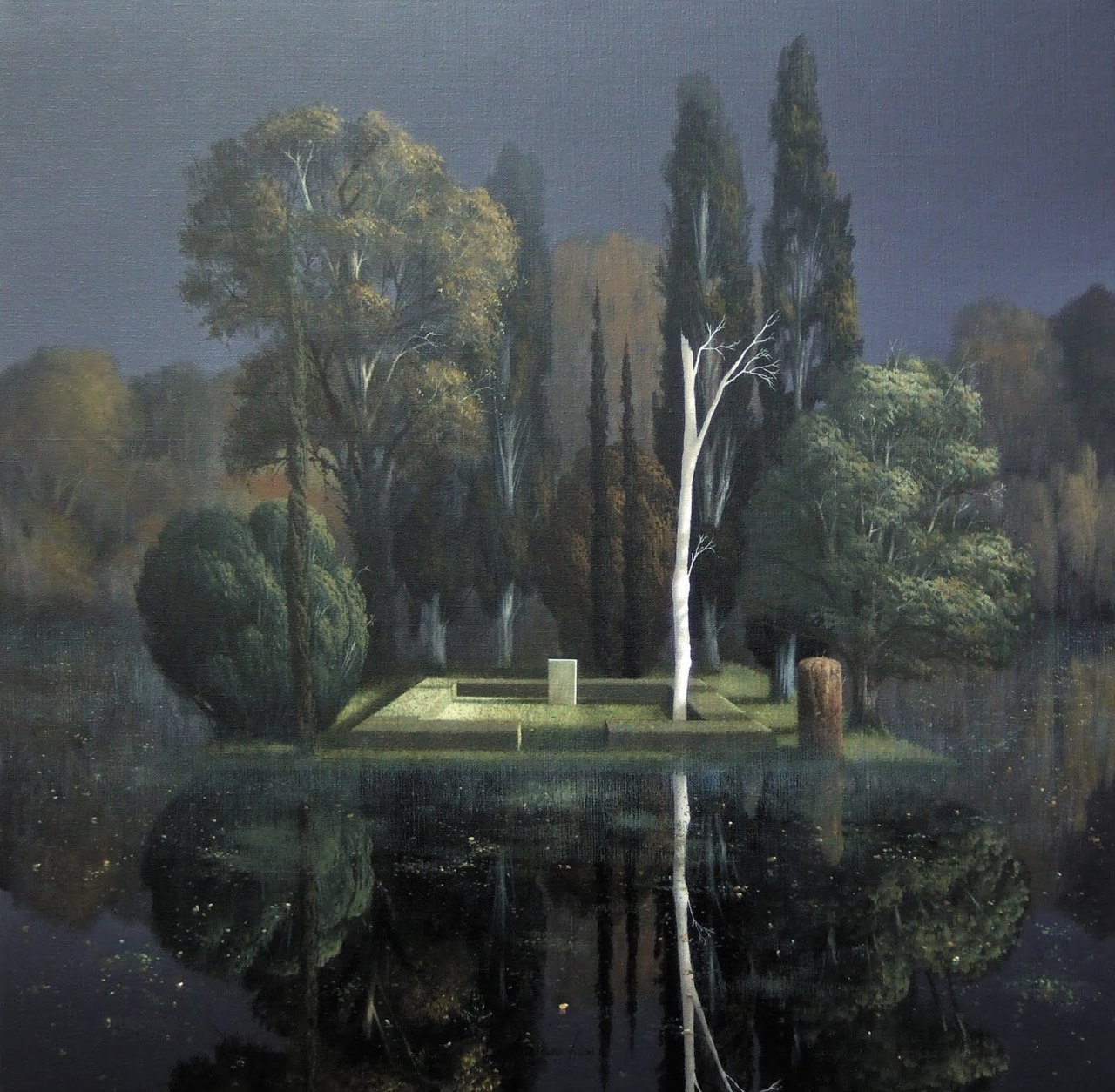
From the very beginning of the myth and its re-actualization through the rite, therefore, Saturn / Kronos is configured as the (de) fallen Lord of the Hyperborean Pole, he who, in the words of Santillana and Dechend [Hamlet's mill, p.180]:
[...] his son Zeus dethroned him by throwing him off the "chariot" and exiled in "chains" to a blessed island where he dwells asleep because, being immortal, he cannot die [but lives] in a kind of life-in-death, wrapped in funeral linens until, according to some, the time for his awakening comes and he will then be reborn to us as a child.
We will return later to this apparently bizarre belief, and we will also have the opportunity to mention other legends based on the same mythologem of divine or deified characters sleeping in some hidden place waiting for an upcoming return. For the moment, always remaining in the context of the radical *krn, there is to mention another Hellenic god who similarly to the Saturn of the golden age was sometimes considered connected to a polar and inaccessible place, suspended in a dimension of timelessness.

Apollo Karneios, the sacred betyls, the cube and theOmphalos
We are talking about Hyperborean Apollo, among whose epithets it is necessary here to recall that Karneios [cf. Cernunno, Odin, Dionysus and other deities of the 'Winter Sun'] which links it to the Karn [D'Anna, p. 44], the elevated place which symbolizes the sacred mountain of the Pole and therefore theAxis of the world. This etymology is also found among the Celts they called cairns the vertical piles of stones, also representations of the cosmic axis. Note that the cult of Apollo also included the worship of a vertical stone, theOmphalos of Delphi, which we can easily relate to the mount Meru of the Indo-Arî tradition and with the lingam of the śivaist Indians.
A was also sacred to Apollo stone cube that in the sanctuary of Delos served as an altar, and the cube, as is well known, is also esoterically connected to Saturn / Kronos [cf. Santillana and Dechend, Hamlet's mill, Postal Code. XV], even in more recent times (hermetic and alchemical treatises, ed astrological). But there is more. There is in fact a very vast ancient tradition [cf. Eliade, Treatise on the history of religions, p. 195 ff] focused on the theme of sacred betyls, stones "fallen from heaven", that is to say meteoritic rocks mostly black, which after being carved in the shape of the cube were placed in the central point of the sanctuary, which was founded exactly in the place where the betyl had fallen: the meteoritic event was read as a segno divine.
The cubic shape that was given to the rock coming from space can be explained by the fact that this parallelepiped is here to represent the "Fall" of Aion (Being in its eternal and pre-historical aspect) in the cyclical time of the four Yuga Hindu or of the five ages of Hesiod, where the golden age represents the center, and therefore the timeless dimension, and the next four - of silver, bronze, heroes and iron - are equivalent to the four sides of the cube of Saturn, which seen from above (and therefore from the Pole) appears as a square.
It can be seen that this is in connection, in Puranas Hindu, with theWhite Island called Svita-Dvipa, equivalent of Hyperborea, which has its mythical center / pole in Mount Meru, which in turn rests on four supports: east of gold, south of iron, west of silver and north of bronze. From Mount Meru flow the four rivers derived from the celestial Ganges that flow from the feet of Viśnu, near the Polar Star. According to scientist Richard L. Thompson [cit. in Godwin, The polar myth, p. 22], such mythical places described in See And in the Puranas:
[...] impossible to locate anywhere on Earth or to reconcile with the known dimensions of our planet, they are part of a larger cosmos, arranged on several levels, occupying the same space as ours, which the beings of the first Yugas were able to perceive.
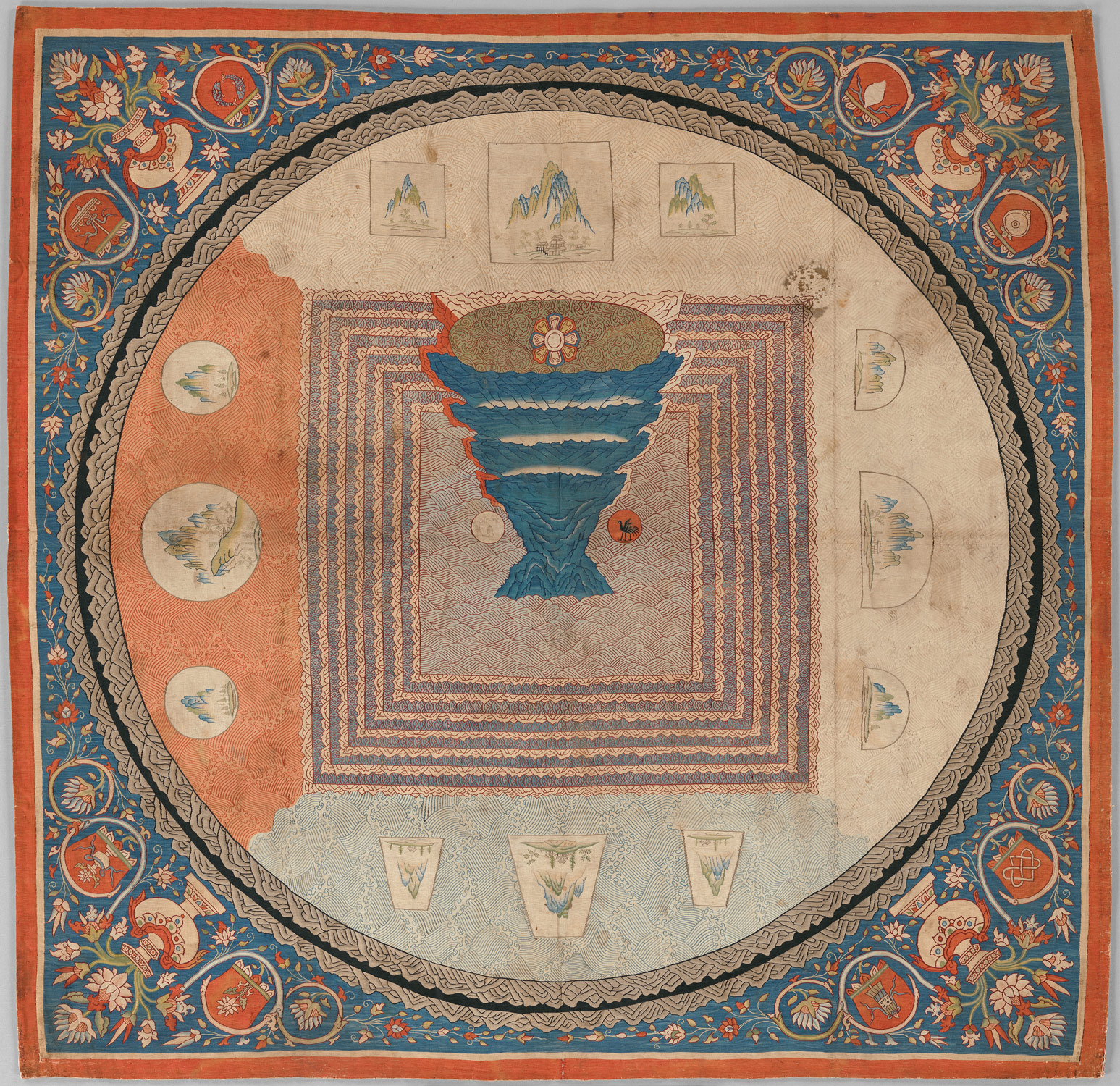
Also mandala of the Sino-Tibetan tradition, in addition to the Indian ones, are equally cosmic images centered on the union between the circle and the square and on the fourfold subdivision (which becomes quinaria also taking into account the center). The same goes for the Native American representations of the "Sacred Circle of the Cosmos" [cf. The Sacred Circle of the Cosmos in the holistic-biocentric vision of Native Americans].
The dark color of the cube sacred to Saturn / Apollo Karneios it alludes to the phase of the definite alchemical work Nigredo: from the purity of the paradisiacal origins we have now fallen into the coils of time, and the Saturn of the golden age is now configured as Kronos, the "Time-that-devours everything", equivalent to the Hindu Śiva which with its dance without rest creates and destroys the cosmos during the various cosmic cycles, whereas Viśnu instead personifies the deity of the timeless and perpetually above and outside from the patrols of Samsara fleet.
So we understand how the "evil" aspect of Saturn / Kronos-Śiva is nothing more than the consequence of his "fall into temporality": Kronos is Aion entangled in the patrols of cosmic cycles, who nevertheless continues to rule from his occult abode. Likewise, Śiva is Viśnu in his aspect of conservative and destroyer: while Viśnu creates the cosmic manifestation "by dreaming", it is Śiva who keeps it in perennial existence with its double dance of creation and destruction [cf. Cyclical time and linear time: Kronos / Shiva, the "Time that devours everything"].
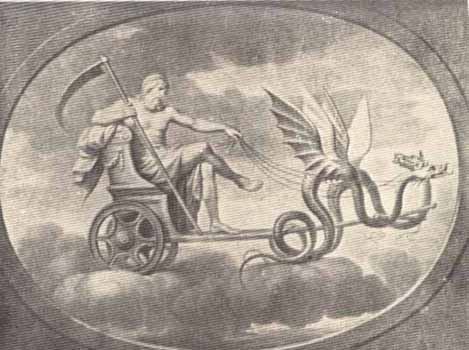
The "fall of Being" into the world of becoming
The tragedy of the exile of Aion / Kronos in the patrols of time concerns, from a more esoteric point of view, every single conscious entity of the entire cosmos: behind the anthropomorphizations of the myth lies the terrifying mystery of the "fall of Being" in the world of becoming or, for the Hindu tradition, of the Maya (illusion caused by becoming). The radical *Sat in Sanskrit it stands for "pure essence", "truth", hence the name of the golden age in the Indian tradition: Satya Yuga. Its term coincides with the end of a heavenly and hyperborean world, and with the disappearance or rather theconcealment of the primordial Center / Pole.
Likewise in the Greco-Roman myth, following the dethronement by Jupiter, the demiurgic god ruling the cosmos from the Silver Age onwards, this "Land of the Gods" in which during the golden and primordial age man lived in company of the gods under the aegis of Saturn, with the new configuration of the cosmos ruled by Zeus is suddenly hidden, becoming almost a "Land of the Dead", which finds sublime imaginal representations in the soul of painters of the sensitivity of Arnold Bocklin.

Apollo in koma for a "Great Year"
It is curious to note how Apollo, similarly to Kronos, comes in a myth condemned by Zeus to exile, far from Olympus. The Belgian historian of religions treats it in an exemplary way Marcel Detienne In his work Apollo with the knife in his hand. Following the killing of his son Asclepius, guilty of having wanted to snatch a soul destined for her by the Cyclops, the Hyperborean god waged a fight against the killers, a militia of Zeus to whom they had conferred, following the battle against Kronos, thunder and lightning. Zeus was about to punish Apollo by making him fall into Tartarus but, following Latona's prayers, he agreed to send the rebel into exile: "one year, one "Great year" of slavery in the employ of a mortal, to take care of his flocks»[Detienne, p. 258].
In this circumstance, the portrait of Apollo sketched by Detienne is perfectly correlated with the mythology of Saturn / Satan / Lucifer fallen from the sky by the demiurgic god who rules the flow of becoming (Zeus / Jupiter / Yahweh) and forced into exile on earth (or inside—In Tartarus—, or better in one size superimposed but invisible, the Isle of the Blessed or Ogigia or Avalon) for the duration of an entire cosmic cycle, in a condition of comatose numbness [Detienne, p. 258]:
Fallen Apollo; the god of unlimited pride, who always wants to be the first, condemned to lead the existence of a poor devil, reduced to slavery [...] the immortal who lied lies "breathless and speechless on a well-laid bed ", Victim of a numbness, koma, cruel [...] Radical exile, in which immortality seems suspended, now that he has become the slave, the day worker subjected to the whims of a mere mortal, the god, excluded from Olympus and from "always", experiences the life of the ephemeral, of being subjected to the "day", to the daily change, to what, every day, happens to him.
In this myth, Apollo condemned to exile by Zeus is the same Aion / Golden Saturn who became Kronos following his precipitation in Tartarus: excluded from eternity ("from Olympus and forever") Is subjected to time, to the ephemeral, to change: Being (Sat), after the "fall into the world of becoming" it is corrupted, transmuting into the dark and leaden Kronos. The planet Saturn, which as the outermost planetary body of our solar system known to the ancients, actually corresponded to the highest of the planetary spheres in their cosmic-sacral conception (the "Seventh heaven" or the Stya-Loka of the Hindu tradition) is forced to cede the sovereignty of the cosmos to Jupiter / Zeus and from here begins the "fall of Being" into cyclical temporality.
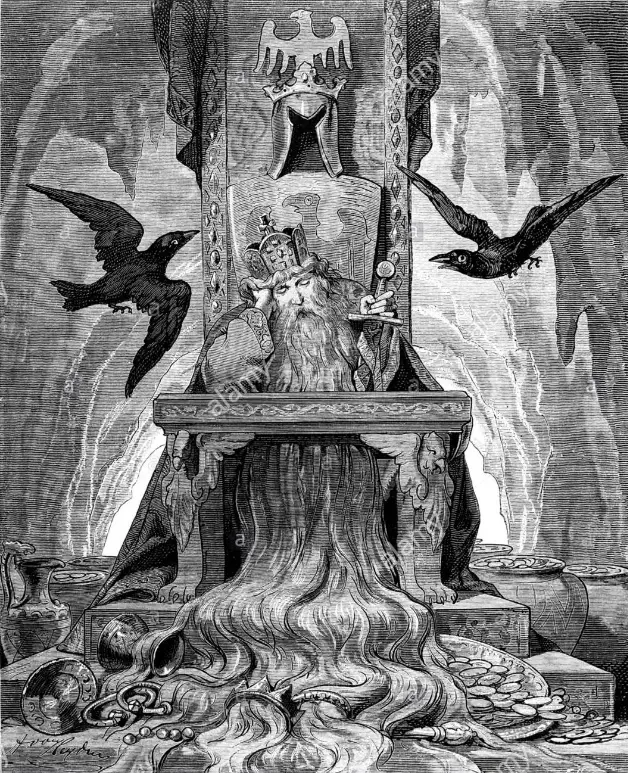
King Arthur and Unther Pendragon: the Bear and the Dragon
We have so far reported the myths centered on this topos regarding Saturn / Kronos and Apollo, but the traditions on divine or deified characters lying in a comatose state and forced to reside until the end of the cosmic cycle in certain places stolen from the passage of time are vast. This complex of legends concerning «characters kidnapped in the invisible, and will "never die", destined to "awaken" or re-manifest themselves at the end of a certain time» are, as Evola notes [Revolt against the modern world, p. 188], "various incarnations of a single theme, transposed from reality to superreality» and also includes the Hindu doctrine of the Avatara or periodic divine incarnations under different personalities, although "express the same function».
These beliefs are found for example in the sagas that convey the idea of a future return of Odin, King Arthur (from arctos= "Polo", but also arkhtos= "Bear") and Federico Barbarossa from their respective 'inferior' residences (Avalon, Etna, the Kyffhäuser in Thuringia). It should be borne in mind, however, that the infernal aspect of such places should not be understood in a merely chthonic-underground sense, but rather, as we have emphasized elsewhere [cf. Divinity of the Underworld, the Afterlife and the Mysteries]:
[...] behind a purely telluric-chthonic idea of depth it seems to hide, in the wisdom of Myth and Tradition, a much deeper dimension, decidedly more abyssal, and I will nevertheless not in a physical-material sense (the subsoil), not on this earth: but in the skies, in the cosmic Abyss. In Hellenic mythology, this abyss is named Tartar: in Phaedo (111e-112b) Plato speaks of this place as an abyssal dimension, not subterranean to our world but rather superimposed, probably alluding to its extra-temporal dimension (Avallon, the Island of the Hesperides, Ogygia).
Also Santillana and Dechend I am of this opinion, since they write [Hamlet's mill, p. 240]:
The difficult word Ὠγυγίoη, often translated as "primordial" seems to designate things vaguely situated beyond space and time, how to say: the hidden treasure where the rainbow descends. It was also the name of the retreat of Kronos, where the god awaited the moment of his return [...] This "ogigia" region, abhorred by the gods, must be below and together beyond the earth, which means something like "On the other side of the sky".
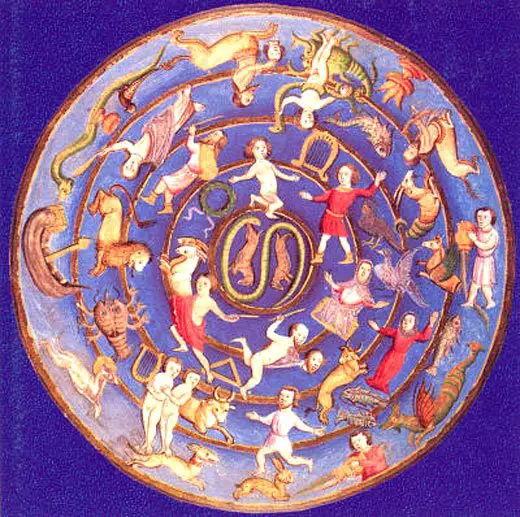
In this sense, when the myth tells that Arthur or Saturn / Kronos or the sleeping Emperor Barbarossa lie in a comatose state in their underground abodes awaiting a future awakening, we must interpret these beliefs with the tools of theastrotheology [cf. Cyclic time and its mythological meaning: the precession of the equinoxes and the tetramorph, A Science in Tatters: Survival of the Doctrines of Cyclic Time from the Timaeus to the Apocalypse e Stellar symbolism and solar symbolism]. In fact, as awe had the opportunity to note in a previous article [cf. The Friulian benandanti and the ancient European fertility cults]:
The characters of Odin and Arthur are both related to the bear [...] The animal [...] evokes possible references to polar star (Ursae Minoris) as well as axiality (the sacred ash tree Yggdrasill, the World Tree to which Odin hangs for nine days; the sword that Arthur pulls out of the rock). Chiavarelli points out that the bear is also semantically evoked both by the name Arthur (arktos, bear), and by the denomination of the "bands of warriors" bears "of Odin's army, the berserkirs, twelve, among other things, as the knights of the Breton sovereign "(Diana, Arlecchino, p.29).
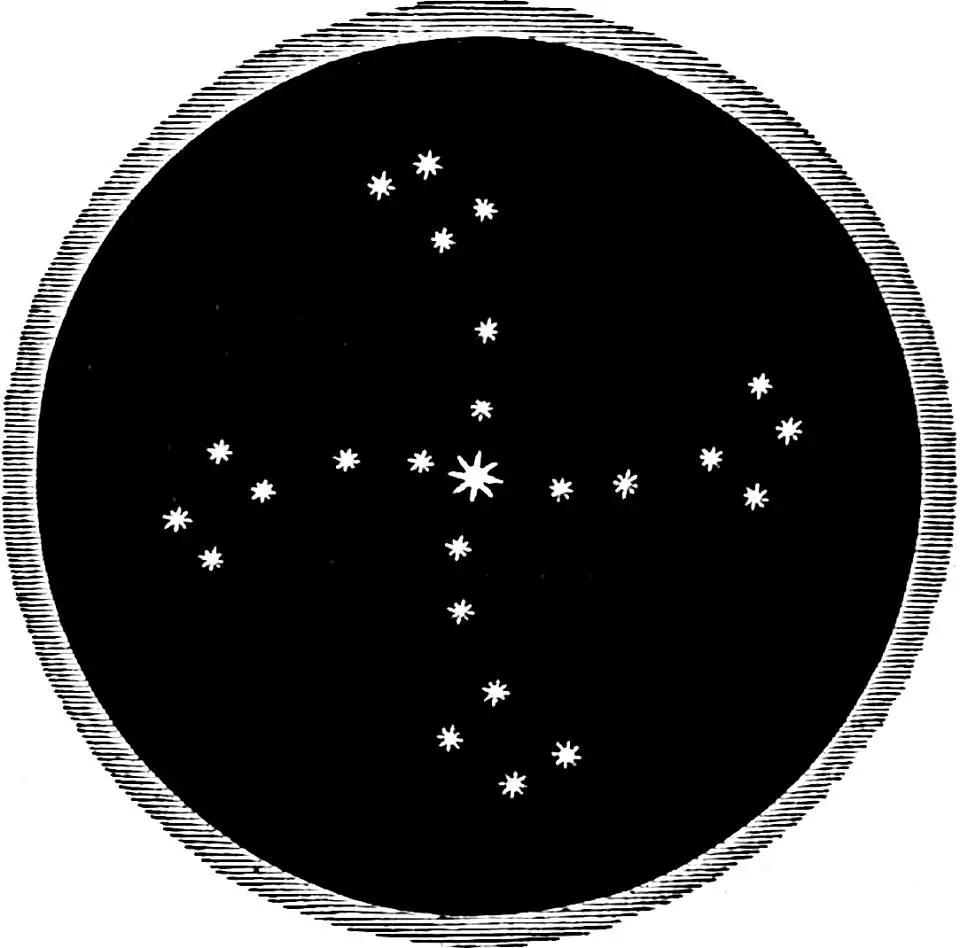
But there is more. According to the Breton tradition Arthur would be the son of Uther Pendragon (literally: "Dragon Head"). The dragon is an even more primordial symbol of the Bear, and this must be reconnected, as the reader may have already understood, with the constellation of Draco and above all with its "head": the star alpha-drakonis. Indeed, we know that this star, known to modern astronomers as Thuban, held the position of North Star about 5000 years ago, a date curiously close to the birth of the most complex and evolved civilizations in the history of our planet, and probably a period in which the first corporate mythical that were then perfected in the following millennia. Once again you can't help but notice how, at the beginning, the world of the Sacred and the observation of the stars were practically inseparable: the religious sentiment was born precisely from the attempt of some elite scholars to decipher the language of the Cosmos and to understand the position and role of man within it.
It is therefore clear—to return to the myth of Arthur - who, being the "Dragon Head" (Uther Pendragon) father of the "Bear" (Arthur /arkhtos), it follows that the symbol of the Dragon /Ouroboros, always central to the myths of origin and cosmogony (think for example of the Mexican Quetzalcoátl, "Feathered Serpent" who created the world) is to be conceived as prior to that of the bear, which represents, so to speak, a second phase that follows the «fall of Being into the world of to become », with which the golden age ends or Satya Yuga. And in fact, in today's age the North Star is α-Ursae Minoris, or Polaris.
Also take into account the symbolic value of the Round Table, considering that the circle symbolizes the timeless eternity of the Center / Pole (Arthur) and that the 12 knights who take their places are nothing but esoteric representations of the twelve zodiacal stations in which the sun takes up residence during the cycle of the year in cosmos now subject to the process of becoming. As mentioned, the Bear is "younger" than the Dragon, which is why under the dominion of Arthur /arkhtos the cosmos now proceeds according to the quadruple divisions of the square, exactly like the cosmos of Jupiter / Zeus following the dethronement of his father Saturn / Kronos, equivalent to Uther Pendragon, father of Arthur.
From that predominant position the symbol of theOuroboros which is associated in the Hellenic tradition with Okeanos and Aion, viz space-time cohesive in an atemporal eternity prior to its subdivision, therefore, before the cosmos was configured according to the dictates of Zeus and on the quaternary subdivision typical of the Demiurge.
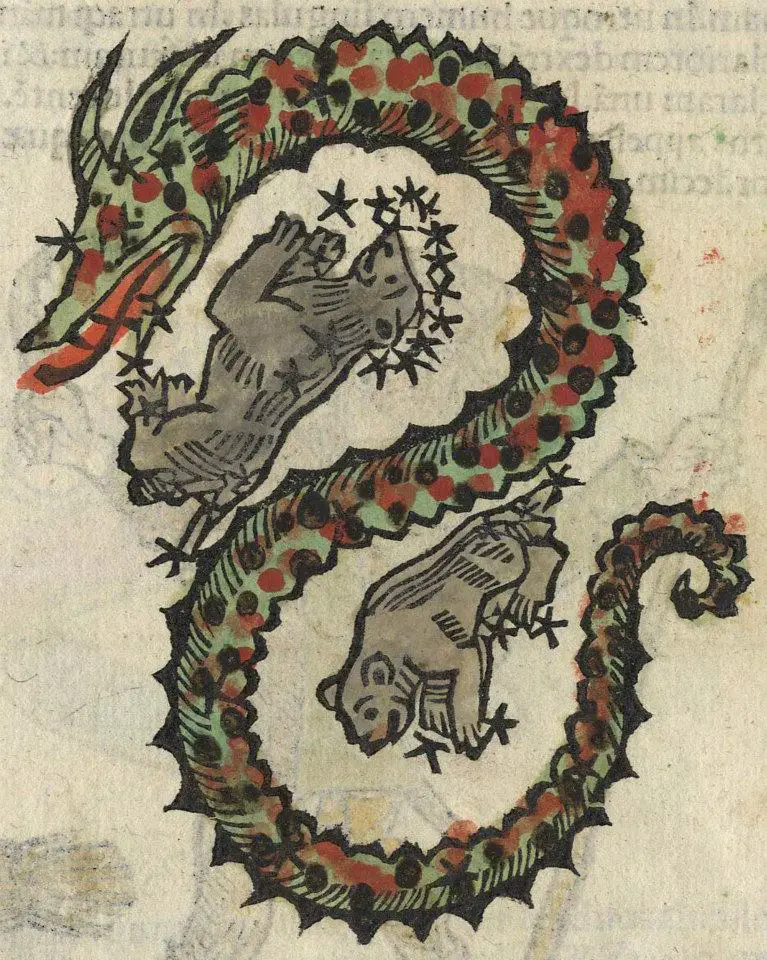
THEOuroboros, Pythian Apollo, Viśnu and Śiva
What has been said about the constellation of Draco is connected to the legend of Apollo slaying the dragon Python at the sacred Omphalos Delphic. Apollo in this myth appears at the same time as the slayer of the Dragon and as the Dragon himself: Apollo Pythia. A similar symbolism is found in Indian myths concerning the supreme god of the pantheon, Vishnu, which is represented laid on the coils of Ananta, the cosmic serpent (Viśnu Anantaśāyin). So writes the German orientalist about it Heinrich Zimmer in his seminal work Myths and symbols of India [pp. 62-63]:
The god lies in his sleep in a graceful, relaxed position, like absorbed in the dream of the universe contained within him […] Viśnu's shoulders and head are surrounded and protected by nine snake heads with their hoods spread out; the god lies on the mighty coils. This many-headed snake is the animal equivalent of the anthropomorphic sleeper. It is called Infinite (ananta) and also Remaining, Residual (śesa). It is a figure that represents the remnant that remained after the earth, the upper and infernal regions, and all their beings, were molded and drawn from the cosmic waters of the abyss.
Epperò Viśnu also has another vehicle: the bird Garuda, which paradoxically is "the snake's adversary" [Zimmer, p. 75]. But this, in mythical-traditional terms, is not at all contradictory, since Viśnu is the god beyond all dualism, who sleeps blissfully absorbed in his cosmic dream, exactly like Kronos near Ogygia or as King Arthur in his subterranean abode. Just as the dual role of Apollo killer of Python and himself is not paradoxical Pythia, the new numinous power of the Delphic oracle, nor is the "mount" par excellence of the Hyperborean god, the swan immaculate, equivalent of the solar bird Garuda, symbol of pure Being beyond any temporal constraint, the white color symbolizing the purity of the timeless Being before the "fall into becoming", resulting in the fixation of the seven colors of the rainbow, equivalent to the seven planets known to the ancients.
Wanting to go even further (and concluding), it is not even paradoxical that, in the Indian tradition, the snake is sacred not only to Viśnu but also to VAT, the two being respectively the deities of the atemporal and primordial dimension one (Viśnu) and del cosmic game of becoming the other (Śiva). They are therefore functionally equivalent, one to the primordial Aion (the golden Saturn), the second to the exiled Kronos who governs the world of becoming after the "fall": it is no coincidence that Śiva, exactly like Kronos, is also configured as god of Time and Death in the appearance of Mahakala, "Time that Devours Everything" [cf. Cyclical time and linear time: Kronos / Shiva, the "Time that devours everything"]. Like this, in the Mediterranean as in the Hindu tradition, the main numinous powers are ultimately characterized as images of Being in the two opposite moments of timeless eternity and existence within the river of becoming.
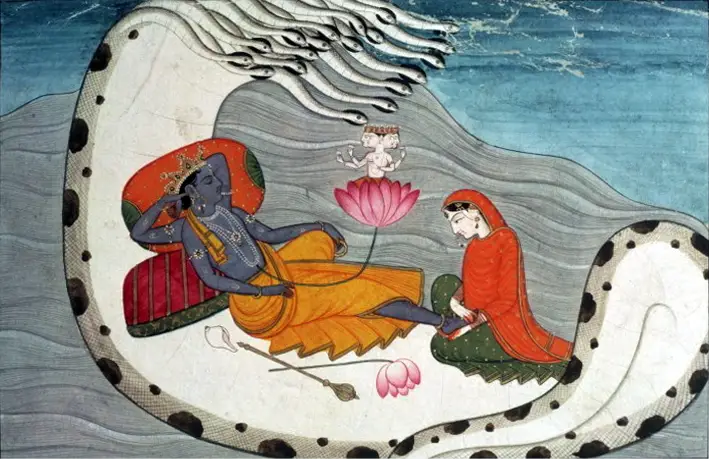
Bibliography:
- Emanuela Chiavarelli, Diana, Harlequin and the flying spirits (Bulzoni, Rome, 2007).
- Nuccio D'Anna, The cosmic game (Mediterranee, Rome, 2006).
- Marcel Detienne, Apollo with the knife in his hand (Adelphi, Milan, 2002).
- Mircea Eliade, Treatise on the history of religions (Bollati Boringhieri, Turin, 2016).
- Julius Evola, Revolt against the modern world (Mediterranee, Rome, 1969).
- Joscelyn Godwin, The polar myth (Mediterranee, Rome, 2001).
- Marco Maculotti, The Friulian benandanti and the ancient European fertility cults.
- Marco Maculotti, Divinity of the Underworld, the Afterlife and the Mysteries.
- Paula Philipsson, Origini and forms of the Greek myth (Boringhieri, Turin, 1983).
- Marieli Ruini, introduction to E. Chiavarelli, Diana, Harlequin and the flying spirits (Bulzoni, Rome, 2007).
- Giorgio de Santillana and Hertha von Dechend, Hamlet's mill (Adelphi, Milan, 1983).
- Heinrich Zimmer, Myths and symbols of India (Adelphi, Milan, 2012).

18 comments on “Apollo / Kronos in exile: Ogygia, the Dragon, the "fall""